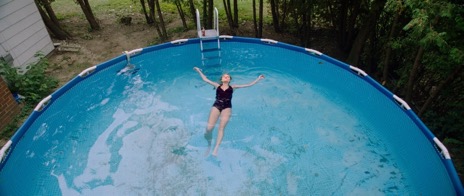A Tale of Two Pools
Skip other details (including permanent urls, DOI, citation information)
: This work is licensed under a Creative Commons Attribution 3.0 License. Please contact [email protected] to use this work in a way not covered by the license.
For more information, read Michigan Publishing's access and usage policy.
The first shot of Jay (Maika Monroe), the protagonist in It Follows (David Robert Mitchell, 2014), announces the film’s interest in interrogating suburban spaces: she is floating in an above-ground backyard pool, blue water around her, as the camera shoots from an omniscient point of view. Private backyard swimming pools are a fixture of suburban spaces, a mark of difference from the crowded public urban pools. As Jeff Wiltse argues in his illuminating history of public swimming pools in the United States, Contested Waters, the rise of private backyard pools can be linked to developments in concrete technology and the forced integration of formerly segregated urban public pools following the Civil Rights movement.[1] Thus, the backyard pool with the lithe young blonde girl floating in it announces that this is partially a film about the suburbs and about whiteness.

In It Follows, Jay goes on a date with a boy named Hugh. By having sex with Hugh, Jay contracts a fatal curse. “It” will follow her around, slowly, taking the form of various people in order to get close to her. If “It” catches her, she will die, but she can get rid of the curse by sleeping with someone else. In this vaguely 1980s era Detroit, it would be easy to read this death by sex as a metaphor for AIDS, or another sexually transmitted disease, but it’s more than that. I’m particularly interested in the way the film interrogates the overwhelmingly northern white suburbs of Detroit.
While the movie evokes a very specific sense of place, its sense of time is more nebulous. None of the characters have cell phones, they use old yearbooks to track down the guy Jay sleeps with instead of Facebook, and the music has a real 1980s feel, but there’s very little that explicitly dates the film. Instead it is the absence of certain things that suggest the dislocation. When Jay enters the house from the pool, she finds her sister and some of their friends watching an old black and white movie on the television. Killers From Space is a Cold War era film about an atomic scientist/pilot who is abducted by aliens while on a reconnaissance mission. He is unhurt by the aliens, but he learns of their plans of destruction and when he returns to base, the U.S. Army doesn’t believe what he’s seen. This is also roughly what happens to Jay.
Although her friends cannot see the being that chases Jay, they agree to help her run from it, to try and keep her safe as best they can. This escape takes place against the backdrop of suburban Detroit. At first they run by heading north, away from the city, to a friend’s parent’s lake house; a retreat of wealth and leisure. But “It” tracks them there, and they return to suburbia. But Greg is killed by “It” in his suburban bedroom, so the friends hatch another plan that will take them into the city. As they drive into the city, the houses get more run-down and abandoned. They leave the car and walk along the street, as the camera lingers on the crumbling homes and one of the girls comments: “When I was a little girl my parents wouldn’t let me go south of 8 Mile. And I didn’t even know what that meant until I got a little older. And I started realizing that. That was where the city started and the suburbs ended. And I used to think about how shitty and weird was that.”
In trying to escape “It” the friends, at first, reenact the white flight that happened in Detroit in the 1950s and 1960s, as white people left the city to move to the suburbs in droves. The racist housing policies implemented in the United States following World War II are less talked about than other forms of more explicit segregation, but the effects were just as detrimental. The cheap, almost free, housing available to whites of various European ancestry following World War II vaulted an entire group of people into the suburbs and the middle class. This left urban areas bankrupt in the face of crumbling tax infrastructure. Now, it seems that the grandchildren of those white flight-ers are moving back to the city, lured by cheap housing prices as housing rates in other urban areas skyrocket. This too is the path Jay and her friends take after the suburban spaces have been exhausted.
Their destination in the city is a large indoor swimming pool, perhaps owned by the city or a University. The movie echoes its narrative through the use of the two pools: while the private above ground pool is dingy and filled with leaves, the giant urban pool gleams in beautiful chlorine tones of blue and green. The invisible creature that haunts Jay may be a metaphor for many things, which is one of the strengths of the film. In the last shot of the film, Jay and Paul, hold hands as they walk through the suburban neighborhood. At some distance behind them a teenage boy follows; it may be the monster or it may not be. Jay and Paul, the film suggests, have learned to live with their fear. Ultimately, by bookending with these different pool spaces, the film also explores the white privilege of “safe” suburban spaces and the no longer quite so scary decaying urban city spaces.
Author Biography
Simone Becque is a doctoral candidate in the College of Mass Communication and Media Arts at Southern Illinois University in Carbondale. She is currently working on a dissertation about architectural space and the American television sitcom.



